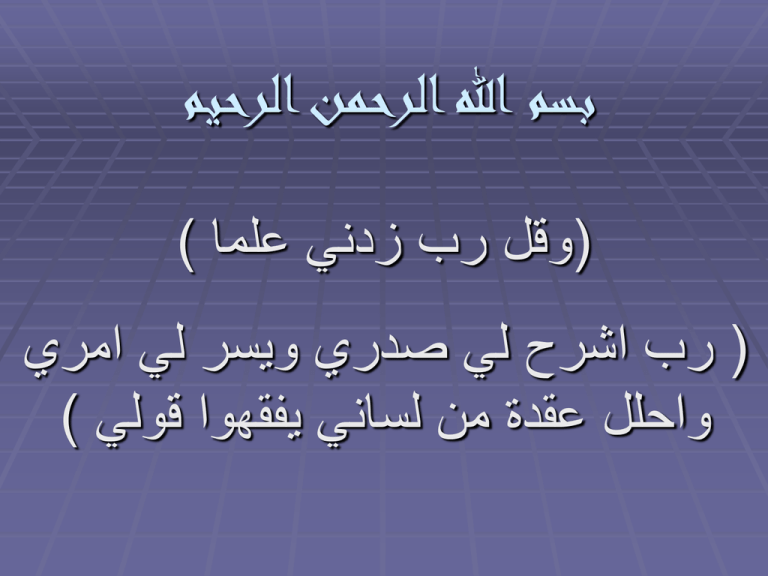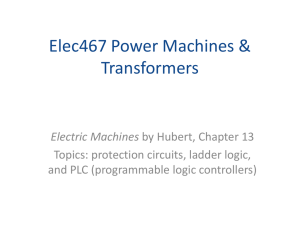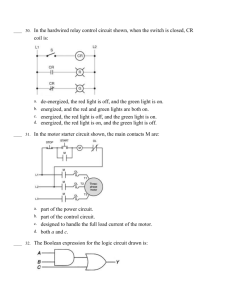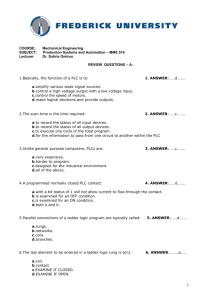Example 12
advertisement

بسم هللا الرحمن الرحيم (وقل رب زدني علما ) ( رب اشرح لي صدري ويسر لي امري واحلل عقدة من لساني يفقهوا قولي ) The Islamic University Of Gaza Faculty Of Engineering Electrical Engineering Department Advanced Technical English Programmable Logic controllers (PLC) BY : Marwan Hammouda Sabri Mohammed Radi To : Dr . Basil Hamad 120030606 120030171 Functions of Controllers : On-off control Sequential control Feedback control Mation control Control Devices: Mechanical control Pneumatic control Electromechanical control Electronic control Computer control Programmable Logic controllers PLCs Were introduced in 1968 Were primarily intended to replace relay devices , so it is appropriate to be familiar with the components used in relay devices PLCs (continue) The National Electrical Manufacturing Associatioin (NEMA) defines the PLC as “A digitally operating electronic apparatus which uses a programmable memory for the internal storage of instructions by implementing specific functions such as logic sequencing, timing, counting, and arithmetic to control, through digital or analog input/output modules, various types of machines or processes. The digital computer which is used to perform the functions of a programmable controller is considered to be within this scope. Excluded are drum and other similar mechanical sequencing controllers." Why is the PLC ? Cost effective for controlling complex systems. Flexible and can be reapplied to control other systems quickly and easily Computational abilities allow more sophisticated control. Trouble shooting aids make programming easier and reduce downtime Reliable components make these likely to operate for years before failure PLC Architecture Program Loader PC Switches Printer Processor I/O Modules Memory Power Supply Machines Cassette Loader EPROM Loader Peripherals External Devices PLC Components : Processor : The processor (CPU) scans the status of the input peripheral , examines the control logic to see what action to take , and then excute the appropriate output response Memory : the control program and the peripheral status are stored in the memory ROM( Read Only Memory ) RAM (Random Access Memory), PROM (Programmable Read Only Memory), EEPROM (Electric Erasable Programmable ROM), EPROM (Erasable Programmable Read Only Memory), EAPROM (Electronically Alterable Programmable PLC Components (continue) Input/Output : modular plug-in periphery Ac voltage input and output Dc voltage input and output Low level analog input High level analog input and output Specail purpose modulas Powre supply : Ac power Peripherals : Hand-Held Programmer ( HHP) CRT programmer Operetor console Printer Simulator EPROM loader Graphics processor A Hand Held Programmer An Allen-Bradley hand-held programmer for MicroLogix 1000 PLC Programming Ladder Diagram - most common Structure Text Programming (ST) Functional Block Programming (FB) Instruction List (IL) Sequential Function Chart (SFC) Ladder Diagram A ladder diagram (also called contact symbology) is a means of graphically representing the logic required Rail in a relay logic system. start PB1 emergency stop PB2 R1 Rung R1 R1 A PLC Ladder Diagram INSTRUCTIONS 1) Relay, 2) Timer and counter, 3) Program control, 4) Arithmetic, 5) Data manipulation, 6) Data transfer, and 7) Others, such as sequencers. Hint : Relay , timer and counter instructions are the most fundemental because they correspond to what is on a ladder diagram and are avaliable on all PLCs so we limit our disscusion to them Relay A Relay consists of two parts, the coil and the contact(s). Contacts: a. Normally open -| |- b. Normally closed -|/|- c. Positive transition sensing -|P|- contact d. Negative transition sensing -|N|Coil: a. Coil -( )- b. negative coil c. Set Coil d. Reset Coil coil -(/)-(S)- input -(R)- Relay (continue) Coil: e. Retentive memory Coil f. Set retentive memory Coil g. Reset retentive memory Coil h. Positive Transition-sensing Coil h. Negative Transition-sensing Coil -(M)-(SM)-(RM)-(P)-(N)- (set coil latches the state, reset coil deenergize the set coil. retentive coil retain the state after power failure.) TIMERS AND COUNTERS Timers: a. Retentive on delay (RTO)- - b. Retentive off delay (RTF)- - c. Reset Input True False RTO counting stop -(RST)RTF stop True counting resume counting stop Counter: a. Counter up -(CTU)- b. Counter down -(CTD)- c. Counter reset -(CTR)- RTO reach PR value, output ON RTF reach PR value, output OFF PR value in 0.1 second TIMERS AND COUNTERS(continue) Clock input Register 5 Accumulator reset Accumulator reset Register contact contact Contact output output COUNTER TIMER THANKS ALL



